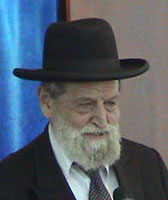Beit Midrash
- Sections
- Chemdat Yamim
- Bemare Habazak - Rabbis Questions
Answer: We will first discuss the practice of many men to always use the beracha on their tallit to cover the tzitzit they put on earlier.
The Shulchan Aruch (Orach Chayim 8:10) says that one who puts on tzitzit when his hands are dirty from the night should recite their beracha only later – after purposely handling the tzitzit or when he puts on another pair of tzitzit. The Darchei Moshe (OC 8:3) relates the minhag to make a beracha only on the tallit he wears at Shacharit, which also covers the tzitzit. The Mishna Berura (8:24) cites various reasons for the Darchei Moshe’s practice. One is that it is wrong to make two interchangeable berachot in close proximity, as one could suffice (beracha she’eina tzricha). The Darchei Moshe (ibid.) was bothered by the possibility that the tzitzit garment will be to small to fulfill the mitzva and warrant a beracha. The Mishna Berura adds other factors that could make a beracha inappropriate for the tzitzit.
This practice does raise problems. Berachot are supposed to precede a mitzva’s fulfillment, whereas here the beracha on the tzitzit comes afterwards. Rabbeinu Yonah (see Beit Yosef, OC 8) says that it is sufficient that the beracha precedes part of the performance of the mitzva, i.e., the continuation of wearing them. The Taz (8:9) adds that when one cannot make the beracha right away because his hands were dirtied during the night, the delay is justified.
You have a different reason not to make a beracha when their time comes (app. 50 minutes before sunrise). The Shulchan Aruch and the Rama (ibid. 16) rule that one who wore tzitzit all night makes a new beracha on them in the morning (as they remain on him) because nighttime, which is not the time of tzitzit, is a break in the mitzva. However, many poskim argue based on Rishonim who posit that the mitzva continues and there is no need or justification for a new beracha. The accepted practice, at least for Ashekenazim (Yalkut Yosef, OC 8:49 cites both opinions), is to not make a separate beracha due to doubt (Mishna Berura 8:42; Tzitzit (Cohen), p. 66)). While there are other possible ways to deal with the doubt, the Mishna Berura recommends the system of using the beracha on the tallit. What is different in your case is that you do not have a tallit to make that beracha. On Shavuot night, when many people are together and with the phenomenon of certain berachot being said by one on behalf of others, someone usually says his beracha on the tallit out loud (those with their tallitot have no need to be yotzei with a central person).
In one way, there is actually an advantage to being yotzei with another’s tallit in comparison to the daily practice of many to having their own beracha on the tallit go on the tzitzit. One should have intention to include the tzitzit, which is easy to forget when preparing to put on the tallit. While some recommend solving by mentioning the tzitzit (Ben Ish Chai, I, Bereishit II) or handling them at that time (see opinion in Tzitzit, p. 42), few do so. There are strong grounds to say that b’di’eved, the intention for the tzitzit does not have to be cognitive when it is one’s standard practice (ibid., p. 43). In any case, in the ceremonious manner it is done by many on Shavuot morning, people are generally reminded that the recited beracha on one person’s tallit is for the tzitzit of all who need it.
Regarding timing, while one could argue to have a beracha made as soon as possible, it is easy to justify the minhag to wait until it is time to daven (Minchat Yitzchak II:4.1). If the daily minhag allowing one to actively put on tzitzit well before the beracha will be made is fine, one who just keeps them on has less problem waiting for the beracha (see Taamei Haminhagim, p. 8).

Bemare Habazak - Rabbis Questions (627)
Various Rabbis
127 - Making a Shabbat Tallit Into a Weekday One
128 - The Timing on the Beracha
129 - Counting Sefira with a Beracha
Load More

Ask the Rabbi: Beracha when Lighting for a Neighbor
Rabbi Daniel Mann | Kislev 5786

Ask the Rabbi: Drawer with Aluminum Foil Roll
Rabbi Daniel Mann | Cheshvan 5786

Ask the Rabbi: How to Tell When Your Tefillin Need Adjustment
Rabbi Daniel Mann | Av 5785






















